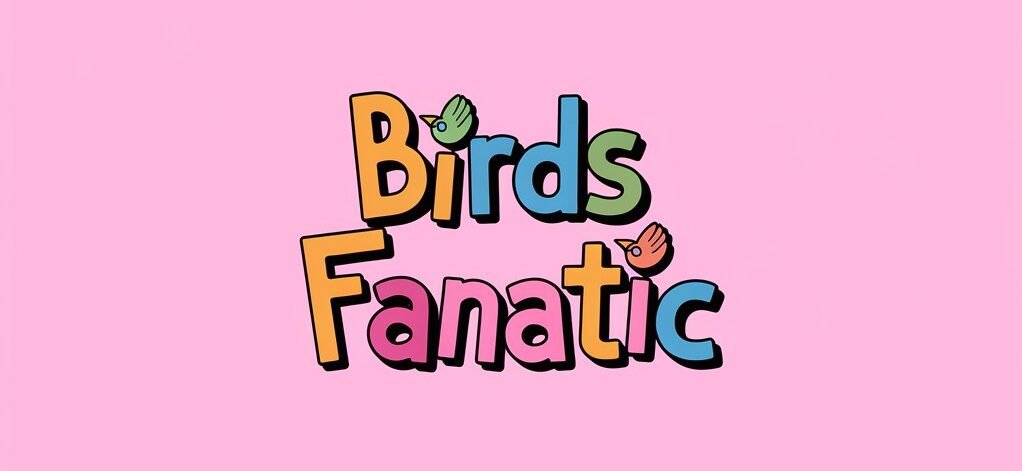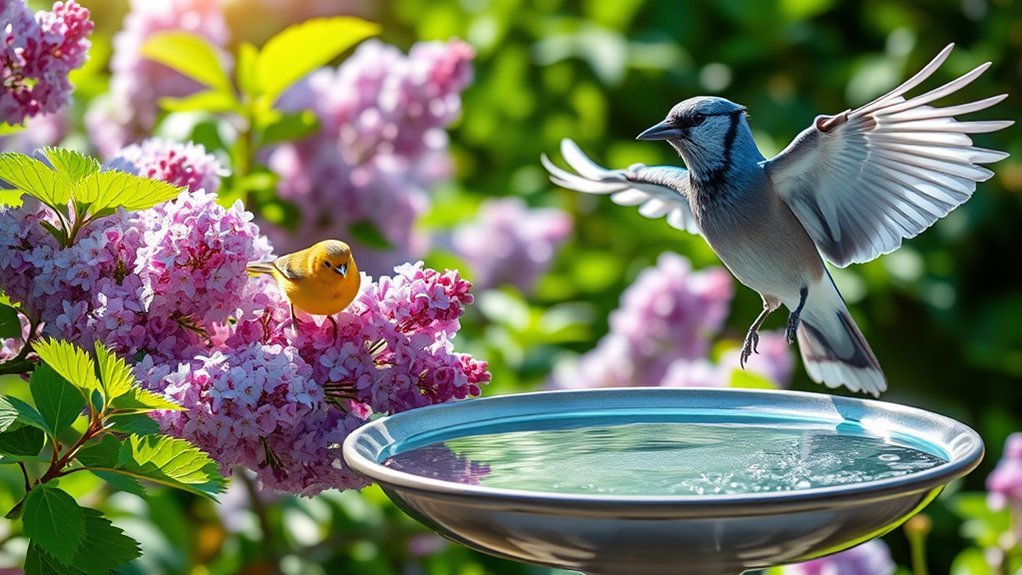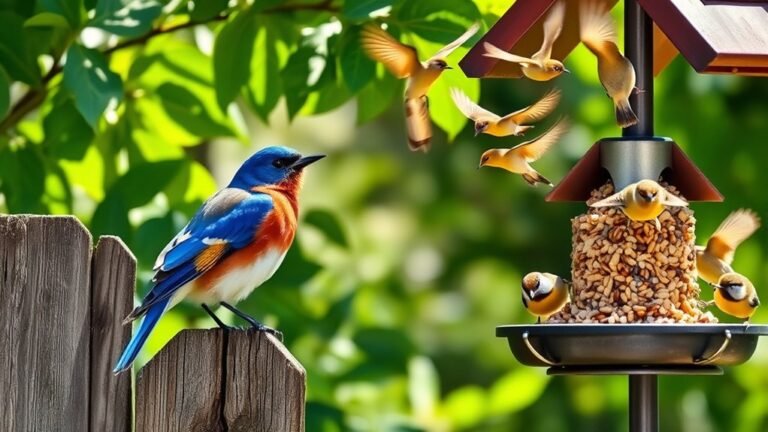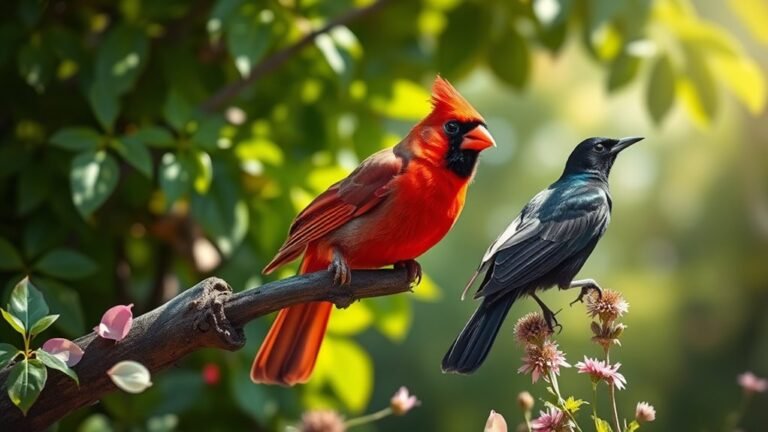Maine Backyard Birds
In Maine, backyard birds offer a wonderful chance to observe local wildlife. You'll see species like the American Goldfinch and Eastern Bluebird showing unique behaviors. Each bird has its own way of finding food and attracting mates, which helps us understand their roles in nature. By learning about these behaviors, you can appreciate your surroundings even more. There are simple ways to attract these birds to your yard, making your outdoor space lively and interesting.
Key Takeaways
- Maine's common backyard birds include the American Goldfinch, Eastern Bluebird, and Chickadee, each offering vibrant colors and engaging behaviors.
- To attract birds, provide a bird bath, nesting materials, and a variety of perches to create a welcoming habitat.
- Use black-oil sunflower seeds and tube feeders to cater to various species while ensuring feeder placement near cover for safety.
- Observing courtship displays and territorial behaviors enhances appreciation for birds and their roles in the ecosystem.
- Different seasons bring unique birdwatching opportunities, from winter adaptations to spring migrations and summer nesting activities.
Common Backyard Birds in Maine

Maine's diverse plants create a welcoming space for common backyard birds that interest both birdwatchers and casual observers.
In your backyard, you'll likely see the American Goldfinch, known for its bright yellow feathers, moving between sunflower plants. The Eastern Bluebird, a friendly visitor, often sits on fences and adds color to your yard. You can take photographs of these beautiful birds as they appear.
Watch how the curious Chickadee interacts with bushes and feeders. Each bird provides a glimpse into nature, helping you feel more connected to your environment.
Enjoy observing this lively ecosystem.
Attracting Birds to Your Backyard
To attract birds to your backyard, create a welcoming space.
Start with a bird bath. Birds need water to drink and bathe, making this an essential feature. Position it in a quiet spot, near shrubs for cover, helping birds feel safe.
Add nesting materials like twigs, grass clippings, and feathers to encourage birds to nest nearby. Include a variety of perches to attract different species.
As you watch the birds come and go, you'll feel more connected to nature. Each small action contributes to a friendly habitat, enriching your yard while inviting birds to visit.
Bird Feeding Tips and Techniques

Feeding birds in your backyard can make birdwatching more enjoyable. To attract different birds, choose the right seeds. Black-oil sunflower seeds draw many species, while nyjer seeds are good for finches.
Use appropriate feeders; larger birds prefer platform feeders, and smaller birds like tube feeders.
Place feeders near bushes or trees to give birds safety and comfort. Keep feeders clean and filled to encourage birds to visit regularly.
This creates a welcoming space for your feathered friends and enhances your connection to them. Every detail matters in making your yard a bird-friendly spot.
Understanding Bird Behavior
Understanding bird behavior enhances your enjoyment of your backyard. By watching courtship displays, you see how birds attract mates. Males often show off bright feathers and sing or dance, showcasing their personalities. Observing these moments connects you with nature.
Recognizing territorial behaviors helps you see how birds claim their space. You may notice aggressive stances, loud calls, or physical conflicts, especially during breeding season.
Understanding these actions builds a stronger bond with your feathered friends. This awareness brings enjoyment and shows you how lively your backyard is.
Seasonal Birdwatching in Maine

Maine offers great birdwatching experiences in each season.
In winter, you'll see birds like chickadees and jays adapting to the cold. They rely on stored food and thick feathers to stay warm.
Spring brings back migratory birds from warmer areas. You'll hear robins and warblers singing and showing off their colors as they claim their territory.
In summer, the landscape is vibrant, and you can observe birds building nests and young birds learning to fly.
As autumn arrives, watch hawks and geese as they migrate, filling the skies.
Each season showcases different birds, deepening your appreciation for Maine's diverse birdlife and the beauty of nature.
Recommended Bird Feeders and Houses
To attract a variety of birds to your backyard, choose feeders and houses that match their feeding and nesting habits. Use different types of feeders: tube feeders are good for finches, platform feeders work for ground feeders, and suet feeders attract woodpeckers.
Each kind targets different bird species, making your yard more interesting.
For birdhouses, select materials like cedar or pine. These woods last longer and keep birds warm. Ensure the entrance hole fits the size of the birds you want to invite.
Also, place houses in sheltered spots to protect them from wind and predators.
With these choices, your backyard can become a welcoming space for Maine's diverse birdlife. Enjoy watching the different species that visit your feeders and houses!
Identifying Different Bird Species
Setting up the right feeders and houses allows you to watch many bird species in your backyard.
Start identifying birds by their size, color patterns, and markings. Observe their behaviors; for example, chickadees often hang upside down while searching for food.
Bird calls also help in identification; warblers have melodic songs, while sparrows make sharp notes. Use field guides or apps to learn these sounds.
Joining local birdwatching groups lets you share your experiences and learn from others. This community connection builds appreciation for the diverse bird life around you.
The Importance of Native Plants
Native plants are important for supporting local bird species in your backyard. They provide essential food sources and habitats. When you choose plants that are native to your region, you help create a healthy ecosystem.
Here are some benefits of native plants:
- They produce nectar-rich flowers, which attract hummingbirds.
- Seed-producing plants provide food for finches and sparrows.
- Dense shrubs create nesting sites for various birds.
- Deep-rooted grasses help prevent soil erosion.
Native plants enhance biodiversity, supporting a lively community of birds and insects. By planting these species, you create a vibrant garden.
This not only improves your outdoor space but also strengthens your connection to nature.
Observing Bird Migration Patterns
As you watch the seasons change, you can see the patterns of bird migration in your backyard. Each year, shifts in temperature and daylight trigger birds to travel to warmer places for winter.
In spring, notice the return of Canada geese and songbirds as they come back with the warm weather and the growth of flowers and food sources.
Observe their flight paths; some birds choose open fields while others prefer wooded areas. By keeping track of their arrivals and departures, you'll connect more deeply with nature.
You can gain insights into their behaviors and the challenges they face. Documenting these patterns will help you understand the ecological rhythms of Maine, creating a stronger sense of belonging in this vibrant ecosystem.
Resources for Birdwatching in Maine
To enhance your birdwatching experience in Maine, use birdwatching apps. These apps help you identify and track local bird species.
Joining local clubs allows you to meet other birdwatching enthusiasts. This creates a sense of community and encourages sharing knowledge.
Here are some useful resources for birdwatching:
- Field guides that describe bird species and habitats
- Online forums to share experiences and tips
- Workshops conducted by birdwatching experts
- Nature trails that provide great viewing spots
Engage with these resources. You'll see more birds and build friendships with others who love Maine's wildlife.
Frequently Asked Questions
What Types of Birdhouses Attract Specific Species in Maine?
Different bird species prefer different materials for their birdhouses. For example, wooden houses attract wrens, while metal houses can keep larger birds away. Understanding these preferences can help you create a welcoming environment for various birds in your backyard, allowing you to enjoy a lively space filled with songs and colors. Choose the right materials to invite a diverse group of feathered friends into your outdoor area.
How Can I Protect My Backyard Birds From Predators?
To protect backyard birds from predators, place bird feeders away from cover. This reduces hiding spots for predators. Additionally, use plants that attract beneficial insects. These plants help create a safe environment that supports bird health and encourages them to thrive.
Are There Any Birdwatching Clubs in Maine?
Yes, there are several birdwatching clubs in Maine. These clubs provide helpful birdwatching resources and offer local meetups. You can connect with other birdwatching enthusiasts and share your experiences. Joining a club is a great way to enjoy your passion for birds and meet like-minded people.
What Are the Best Binoculars for Birdwatching?
When selecting binoculars for birdwatching, pay attention to features such as magnification, field of view, and lens coatings. These factors affect the clarity and brightness of your observations. You can find quality budget options that deliver clear images, making your birdwatching experiences better and more detailed. Enjoy your time observing birds with the right tools!
How Can I Document Bird Sightings in My Yard?
To document your bird sightings, keep a birding journal and use bird watching apps. In your journal, write down details like the bird's appearance, behavior, and the date of the sighting. Apps can help you quickly enter sightings and note additional information. Both methods will improve your understanding of the birds in your yard and make the experience more enjoyable. Happy bird watching!

Hello, I’m Amelia White, the founder of birdsfanatic.com. As a lifelong bird enthusiast and spiritual seeker, I’ve always been fascinated by the mystical connections between birds and the human experience. On this site, I share my knowledge and insights into the symbolic meanings and spiritual significance of various bird species, exploring their roles in mythology, folklore, and cultural traditions. Join me on this journey into the world of birds, where we’ll discover the hidden wisdom and guidance that these magnificent creatures have to offer.






